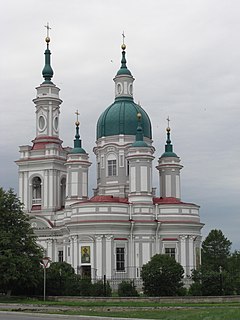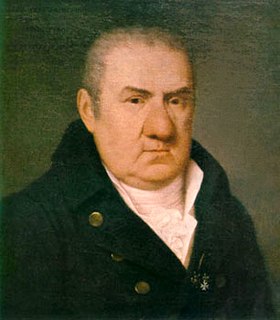
Tsarskoye Selo was the town containing a former residence of the Russian imperial family and visiting nobility, located 24 kilometers (15 mi) south from the center of Saint Petersburg. The residence now forms part of the town of Pushkin. Tsarskoye Selo forms one of the World Heritage Site Saint Petersburg and Related Groups of Monuments.

The Catherine Palace is a Rococo palace in Tsarskoye Selo (Pushkin), 30 km south of St. Petersburg, Russia. It was the summer residence of the Russian tsars. The Palace is part of the World Heritage Site Saint Petersburg and Related Groups of Monuments.

Oranienbaum is a Russian royal residence, located on the Gulf of Finland west of St. Petersburg. The Palace ensemble and the city centre are UNESCO World Heritage Sites.

Alexander Palace is a former imperial residence near the town of Tsarskoye Selo in Russia, on a plateau about 30 miles (48 km) south of Saint Petersburg. The Palace was commissioned by Empress/Tsarina Catherine II in 1792.

Francesco Bartolomeo Rastrelli was an Italian architect who worked mainly in Russia. He developed an easily recognizable style of Late Baroque, both sumptuous and majestic. His major works, including the Winter Palace in Saint Petersburg and the Catherine Palace in Tsarskoye Selo, are famed for extravagant luxury and opulence of decoration.

Antonio Rinaldi was an Italian architect, trained by Luigi Vanvitelli, who worked mainly in Russia.
Admiralty most often refers to:

Nicholas Benois was an Imperial Russian architect who worked in Peterhof and other suburbs of St Petersburg.

Giacomo Quarenghi was an Italian architect who was the foremost and most prolific practitioner of neoclassical architecture in Imperial Russia, particularly in Saint Petersburg. He brought into vogue an original monumental style, of Palladian inspiration, which was a reference for many architects who worked in Russia.

Ippolit Antonovich Monighetti (1819–1878) was a Russian architect of Swiss descent who worked for the Romanov family. Member and professor by rank of the Imperial Academy of Arts.
The Catherine Park is the large landscaped area to the south of the Catherine Palace, located in the town of Tsarskoye Selo (Pushkin), 25 km south-east of St. Petersburg, Russia.

St Petersburg-Vitebsky is a railway station terminal in Saint Petersburg, Russia. Formerly known as St Petersburg-Tsarskoselsky station because its first line led to the suburban royal residences town Tsarskoye Selo, it was the first railway station to be built in Saint Petersburg and the whole of the Russian Empire. Later, with considerable extension of its lines, renamed after a much farther destination - Vitebsk, a city in Belarus.

Ekaterinhof or Catherinehof is a historic island park that began as an 18 century empress's estate in the south-west of St Petersburg, Russia. Its name originated in 1711, when Peter the Great presented the Island and adjacent lands along the eponymous Ekateringofka River to his wife Catherine, whose name they memorialize.

The Ruin Tower is an 18th-century monument in Ekaterininsky Park of Tsarskoye Selo - now Pushkin, a suburban town in eponymous borough of St. Petersburg, Russia. It was designed and constructed in 1771-1773 by German-Russian architect Yury Felten.
Babolovo or Babolovka was a dacha (myza) of Prince Potemkin in Tsarskoe Selo.

Savva Ivanovich Chevakinsky was a Russian architect of the Baroque school. He worked in Saint Petersburg and Tsarskoye Selo.

The Egyptian Gate of Tsarskoye Selo was built in 1829 to replace the old toll-bar, which had been made redundant by the expansion of Tsarskoe Selo.

The Emperor's railway station or Emperor's Tsarskoye Selo Station, known as the Emperor's Pavilion, is a former railway station terminal in Russia, in the town Tsarskoye Selo, which served the last monarch of Russia Emperor Nicholas II with his family and courtiers over his dedicated Emperor's Tsarskoye Selo Railway that eventually consisted of three lines to link the capital city of the empire, Saint Petersburg, with two of the suburban royal residences in the towns of Tsarskoye Selo and Gatchina. The Tsarskoye Selo Alexander Palace and Park estate was home to Nicholas and his family for their last 13 years. The Russian royal family had two other private railway station terminals named Emperor's Pavilions - one in Moscow and another one at Saint Petersburg Vitebsky railway station.
Antonio Bernasconi was a Russian stuccoist born in Switzerland. He worked on decorations in many palaces and other buildings in and around Saint Petersburg, particularly under the architect Antonio Rinaldi.

Ratnaya Palata is Russia's World War I museum building in Pushkin town near Saint Petersburg, Russia. Designed for Romanov royal dynasty's 300th anniversary in Russian Revival architecture style together with the buildings of the church campus of the Sovereign's Cathedral of the Icon of Our Lady of Saint Theodore and the private royal railway terminal. Suggested, not long before World War I, to be built as a museum of Russian war history, based on Elena Tretyakova's collection gift, the exhibition content, when the war was already under way in 1915, was focused by Emperor Nicholas II on then current heroic deeds of Russian warriors, but the display, at first shown in the St Petersburg Admiralty building, opened in Martial Chamber for only a short time before the end of Russian Empire in February 1917, and was closed down a year later by Soviet authorities. Having been used after that for unrelated purposes, the Martial Chamber building was legally transferred to the Tsarskoye Selo Museum complex in 2008 and was cleared, restored, given a new collection of exhibits and reopened as modern Russia's first museum of World War I by the centennial of its beginning in August 2014. The exhibition is titled "Russia in the Great War" after a name for the war used at the time of its battles.















